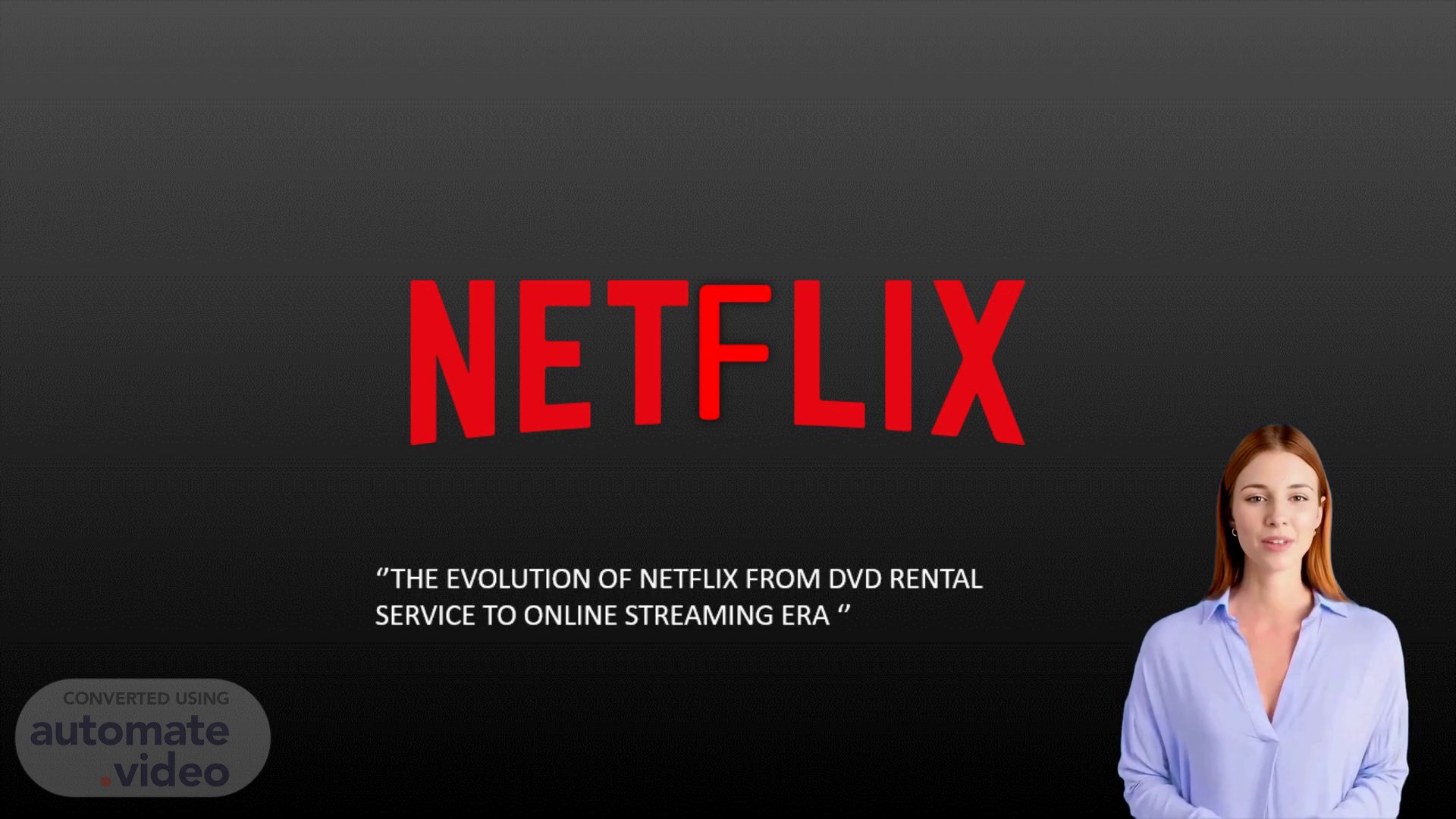
PowerPoint Presentation
Scene 1 (0s)
[Virtual Presenter] F ‘’the Evolution Of Netflix From Dvd Rental Service To Online Streaming Era ‘’.
Scene 2 (8s)
[Virtual Presenter] CONTENTS Introduction Vision Mission Situation Analysis Swot Analysis Conclusion.
Scene 3 (19s)
[Audio] INTRODUCTION Netflix was founded in 1997 by Reed Hastings and Marc Randolph as a DVD-by-mail service. Back then people would sign up for a subscription and receive D-V-D-s in the mail to watch at home. It was a convenient way to rent movies without having to go to a physical store. In 2007 Netflix introduced its streaming service allowing subscribers to stream movies and TV shows directly to their computers. This marked a major shift in the way people consumed entertainment. Over the years Netflix expanded its streaming library and began producing its own original content like the popular series "House of Cards" and "Stranger Things. "Today Netflix has millions of subscribers worldwide and is one of the leading streaming platforms. It continues to release new original content and license popular shows and movies from other studios. It's pretty amazing how Netflix has evolved from a D-V-D rental service to a global streaming powerhouse!.
Scene 4 (1m 20s)
[Audio] mission Netflix's mission is to entertain the world by providing a wide range of streaming entertainment content including movies TV shows documentaries and more accessible anytime anywhere on various devices. They aim to continuously innovate and create compelling original content while enhancing the viewing experience for their subscribers.
Scene 5 (1m 45s)
[Audio] vision Their vision includes creating original and diverse programming utilizing technology for personalized recommendations and expanding globally to reach audiences worldwide. They aspire be the leading entertainment platform constantly innovating to deliver immersive and engaging experiences to their subscribers..
Scene 6 (2m 7s)
[Audio] D-V-D rental ERA Netflix was primarily known for its DVD-by-mail service. Users would sign up for a subscription and receive D-V-D-s in the mail which they could keep for as long as they wanted. They would then return the D-V-D-s in prepaid envelopes to receive their next selection. Netflix had a large catalog of D-V-D-s available for rent giving customers a wide range of choices.
Scene 7 (2m 33s)
[Audio] STREAMING ONLINE ERA After Netflix made the shift from a D-V-D rental service to a streaming platform it experienced significant growth and became a dominant player in the entertainment industry. Here's the situation of Netflix after the transition: 1. Expanding Content Library 2. On-Demand Viewing 3. Personalized Recommendations 4. Disrupting Traditional TV.
Scene 8 (3m 8s)
[Audio] Swot Analysis Strengths Weakness Limited Content Licensing: During the transition Netflix faced challenges in securing licensing agreements with major studios and networks resulting in a relatively smaller content library compared to traditional cable TV. Dependency on Internet Infrastructure: The success of Netflix's streaming platform relied heavily on the availability and quality of internet connections which could be a limitation in certain regions or for users with slower internet speeds. Extensive Content Library: Netflix had a vast collection of movies and TV shows which gave them a competitive advantage in the streaming market. Brand Recognition: Netflix had already established itself as a trusted and popular brand in the D-V-D rental industry which helped them gain a loyal customer base during the transition..
Scene 9 (4m 1s)
[Audio] Swot Analysis Threats Opportunities Competition from Established Players: As Netflix entered the streaming industry it faced competition from established players like Hulu and Amazon Prime Video who already had a foothold in the market. Piracy and Illegal Streaming: The rise of piracy and illegal streaming posed a threat to Netflix's revenue and subscriber base as users had alternative ways to access content without paying for a subscription. Growing Trend of Digital Content Consumption: Netflix capitalized on the increasing demand for streaming services as more people were shifting towards digital content consumption. Global Expansion: The transition to a streaming platform allowed Netflix to expand its reach globally entering new markets and catering to a diverse audience..
Scene 10 (4m 56s)
[Audio] financial IMPACT When Netflix made the shift from a D-V-D rental service to a streaming platform it had a huge impact on their revenue. So the shift to streaming was a game-changer for Netflix's revenue. This transition opened up new avenues for revenue generation as streaming allowed them to attract a larger customer base. With the convenience and accessibility of streaming more people were inclined to subscribe to Netflix's service leading to a significant increase in their revenue. This growth was further fueled by their investment in original content which became a major draw for subscribers. Overall the shift to streaming had a tremendously positive impact on Netflix's revenue propelling them to become a dominant player in the streaming industry.
Scene 11 (5m 45s)
[Audio] CONCLUSION In conclusion Netflix made a major shift from being a D-V-D rental service to becoming a popular streaming platform. This transition allowed people to stream movies and TV shows directly to their devices making it more convenient and accessible. With the introduction of original content Netflix has become a powerhouse in the entertainment industry. It's pretty awesome how they adapted to the changing times and revolutionized how we enjoy our favorite shows and movies!.
Scene 12 (6m 17s)
[Audio] 20220301042 Kranti Dhawale 20220301009 Srushti Jagdale.